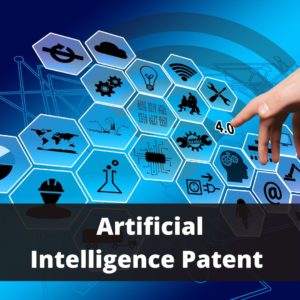In computer science, artificial intelligence is a type of intelligence that is demonstrated by machines in contrast to the natural intelligence which is displayed by humans and animals. Artificial Intelligence also called machine intelligence. The term artificial intelligence describes a machine or computer that mimics ‘cognitive’ functions that humans associate with the human mind, like learning and problem-solving. Artificial intelligence (AI) is the ability of a digital computer and computer-controlled robot to perform tasks associated with intelligent beings.
Patent attorney drafts and file patents for digital tools including artificial intelligence based patents. To prepare strong patent claims for AI or ML based inventions, it can be helpful to review the AI patent landscape.
Get Insights Directly in Your Mailbox
Apple Podcasts | Google Podcasts | Spotify | Others
With many big companies investing in AI/ML-based product development it becomes important that they are patented. Patent rights fall under private law in most of the countries, and the patent holder must sue someone infringing the patent to enforce his or her rights. In some of the industries, patents are an essential form of competitive advantage, and in other countries they are irrelevant.

Initial Public Offering of United Kingdom released a report on worldwide AI patenting activity, which combined with deep dive into the local landscape and how it compares to other countries. The study complements WIPO’s Technology Trends paper that analyses for producing top takeaways piece earlier in the year. The data analyzed for the UKIPO report taken from the EPO’s PATSTAT product. The dataset includes 160,000 patent applications and 85,000 patent families. There are some numbers to bring some of the top takeaways.
China is coming nearer to the US to have the most AI patent applications. The US has still the largest number of AI-related patent applications despite the exponential increase in filing activity in China.
There is a growth in AI patent applications, which is driven by China and The United States. In the year 2014, China overtook the US in concerning AI patent applications and since it has maintained a high growth rate. 19% of applications first filed in China as compared to the US, which recorded with 53%. Internationally, IBM has the largest AI portfolio, which is trailed by Microsoft.
The top UK player is BT Group, with 86 AI patent families. This company has filed in several jurisdictions involving the US, Germany, Canada, and China. In the worldwide, IBM AND GE Aviation Systems, both have features as some of the top applicants worldwide.
UK innovators give the top priority to the US because the US is the most important foreign jurisdiction for protection for British entities. Filing level at WIPO and the EPO is heavily dependent on UK based patent. At CNIPA, filing levels are relatively very low. This is fascinating, considering that China is one of the most important AI markets.
According to the UN, “China and U.S. will lead the race for artificial intelligence patents.” According to a study by the United Nations World Intellectual Property Organization (WIPO), “China and U.S. are ahead of the global competition to monopolize artificial intelligence (AI).” IBM has the largest AI patent portfolio, with 8,920 highest patents. After that comes Microsoft AI patent portfolio with 5,930 patents and a group of mainly Japanese tech conglomerates. China has many academic institutions that are involved in patenting AI, strong in the fast-growing area of “deep learning” a machine learning technique.
Now, we will talk about the Patent Portfolio Valuation. A Key advantage may be to increase the profitability of your business through licensing, selling, or raising finance against the patents. For high tech firms that are technology-driven, a patent valuation can better establish the net worth of the business; especially if it is an intellectual rich organization i.e. excellent people, skills, technology, IP (patents), but perhaps less value in customers, revenues, brand, and channels.
We work with private and public high-tech companies to help drive greater business success through high-performance patent and product strategies. We believe in combining operating company experience in business management, patent strategy, information systems, and operations, with analysis and research capabilities spanning many high-tech segments. The company collaborates with extended high tech companies, from startups to the fortune 500.
Generally, a patent used to exclude others from using the same invention in their business, as your patent describes. It is an invention right, and it is publically available. The owner of the patent has the right to practice the invention described in the patent, but this does not mean that some products will be using all or part of a patent.
Now, we talk about Google’s AI-first Strategy. Since the last year and since the Google I/O, Google has been working hard to continue to shift from a mobile-first to an AI-first world and is rethinking all its core products, and working hard to solve the use of problems by applying machinery learning NAI.
A simple example but it’s the kind of everyday use case for which Google is using machine learning to make a difference with the power of machine learning on their neural machine translation be so over 2 billion translation in many languages every single day. It is not just about applying machine learning in inner products but it’s radically rethinking how computing should work.
At a higher level in an AI-first world, Google believes computers should adapt to how people live their lives rather than people having to adapt to computers and so it thinks about four core attributes as part of this experience. First people should be able to interact with computing naturally and seamlessly. Mobile took up a step in this direction with multi-touch, but increasingly it needs to be conversational sensory. Google believes that it needs to be able to use voice, gestures, and vision to make the experience much more seamless.
Second, it is going to be ambient computing is going to evolve beyond the phone. Be there on many screens around you when you need it working for you.
Third, Google thinks it needs to be thoughtfully contextual. Mobile gave us limited context. With identity and location, Google was able to improve the experience significantly. In the AI-first world, one can have a lot more context and apply it thoughtfully.
Finally, the most important of it all in computing needs to learn and adapt constantly over time. It just does not work that way today. So, Google is excited by the shift, it has been working on software, and hardware together because that’s the best way to drive the shifts in computing forward but they think they are in the unique moment in time where they can bring a combination of AI and software and hardware to bring a different perspective to solving problems for users. Google is greatly confident about the approach here because they are at the forefront of driving the shifts with AI. Three months ago at Google, I/O Google AI teams announced a new approach called Auto ML. Auto ML is just Google’s machines automatically generating machine learning models.
So, Google has been working on this technology called auto ML, and just in the past month for standard tasks like image classification, understanding images. Google auto ML model is now not only more accurate than the best human-generated models but is more resource-efficient.
Google lens, its photography, in pixel, uses object detection which is hard to do. With the best human-generated models Google had only have 30 percent accuracy but their ML models were more accurate and are constantly getting better. So, the rate at which Google is seeing progress with AI is amazing which is why they are excited about combing it with software and hardware to bring together for users.


